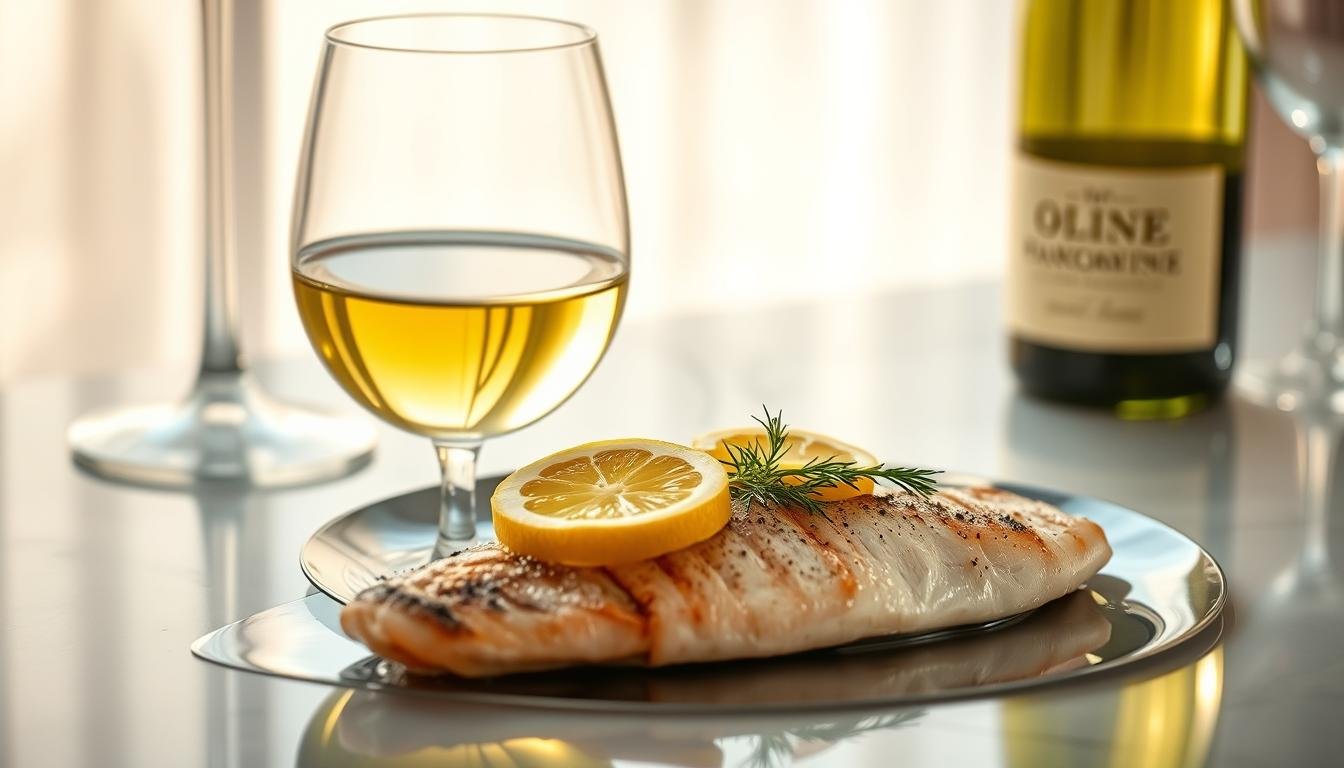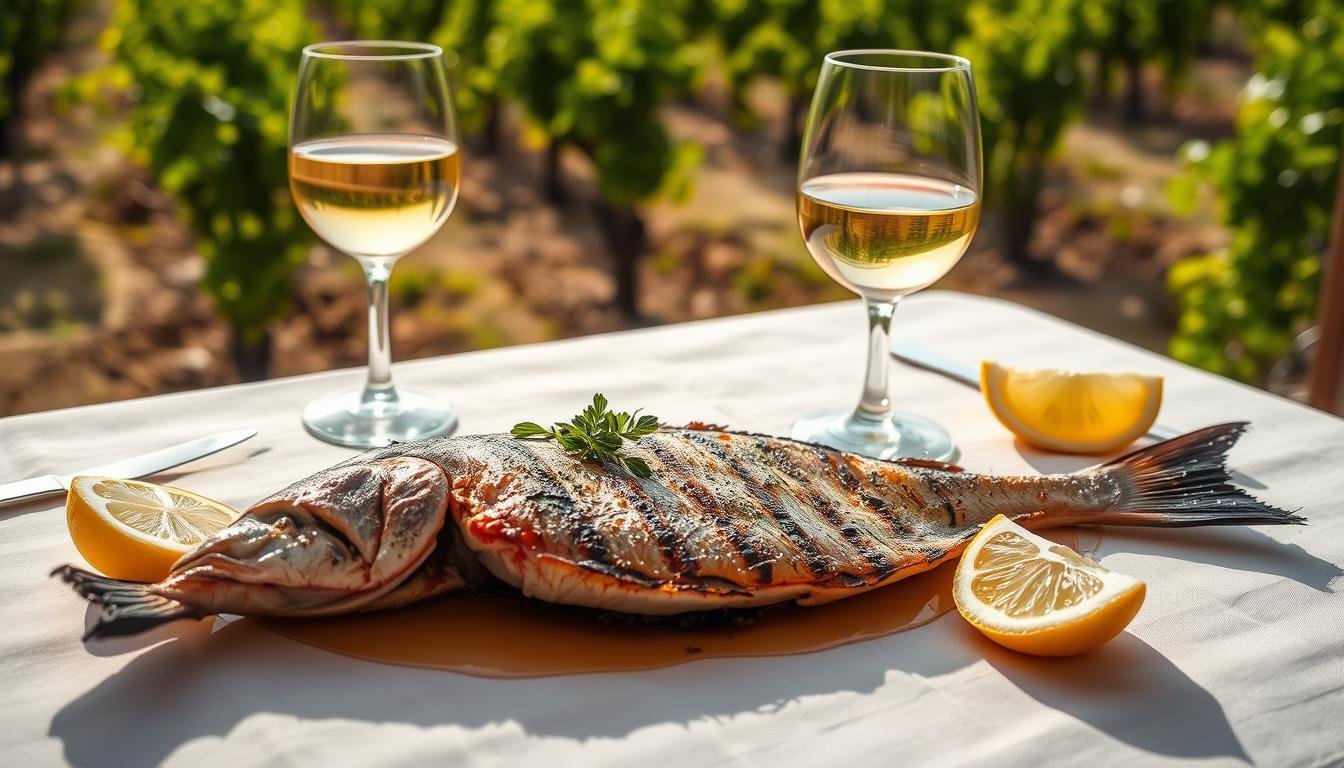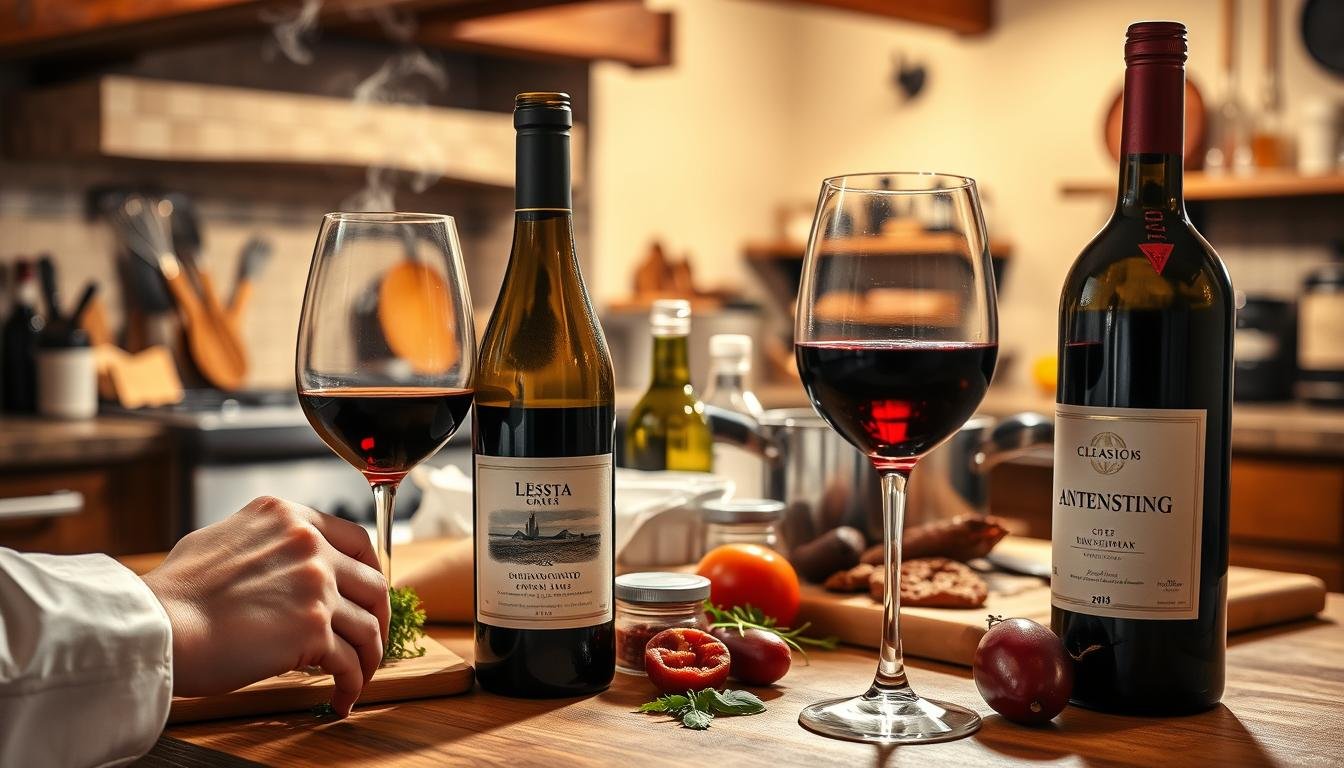The elegance of pairing white wine with fish has been a culinary tradition for centuries. A memorable dining experience at a fine French restaurant in Montreal, where I savored fish with a white wine sauce, highlighted the delicate texture and flavor of the dish.
The combination of white wine and fish is a match made in heaven, with the acidity and flavor profiles of the wine complementing the delicate textures and tastes of various fish species.
Understanding the principles behind this pairing is key to elevating your dining experience. This guide will walk you through the process, from understanding fish categories to creating the perfect white wine sauce.
Key Takeaways
- Discover why white wine and fish create a perfect culinary pairing.
- Learn how the acidity and flavor profiles of white wines complement fish species.
- Understand the basic principles that make white wine and fish work well together.
- Explore how different preparation methods for fish influence wine selection.
- Master the art of pairing the right white wine with your favorite fish dishes.
The Perfect Marriage of White Wine and Fish
The synergy between white wine and fish creates a delightful culinary experience. This classic combination has been a staple in many cuisines around the world, particularly in coastal regions where fresh seafood is abundant.

Why White Wine Works Best with Fish
White wine’s natural acidity acts as a palate cleanser, cutting through the oils in fish and creating a refreshing contrast that enhances both the wine and seafood flavors. The delicate flavors of fish are easily overwhelmed by the tannins in red wine, making white wine’s lighter profile the ideal companion for most seafood dishes.
White wines typically contain compounds that complement the natural oils and proteins in fish, creating a harmonious flavor experience rather than competing tastes. This makes white wine an excellent choice for pairing with a variety of fish, from mild and delicate to meaty and rich.
The Science Behind the Pairing
The science behind this pairing involves chemical interactions between the wine’s acids and the fish’s proteins, which actually enhance our perception of both flavors. Understanding this relationship helps explain why certain white wines work better with specific types of fish, based on their respective intensity levels and flavor profiles.
For instance, a crisp Sauvignon Blanc can complement the delicate flavors of sole or flounder, while a richer Chardonnay might pair better with the meatier texture of salmon or swordfish. This perfect marriage of flavors has been recognized across cultures for centuries, from Mediterranean coastal cuisines to Japanese fish preparations.
Understanding Fish Categories for Better Pairing
Fish can be broadly categorized into three types, each requiring a different approach to white wine pairing. The texture, flavor, and oil content of fish play a significant role in determining the most suitable white wine. By understanding these categories, you can make informed decisions to enhance your dining experience.
Mild and Delicate Fish
Mild and delicate fish, such as sole, flounder, and tilapia, feature light, flaky flesh with subtle flavors. These delicate fish fillets require wines that won’t overpower their subtle taste profiles. A crisp, light-bodied white wine pairs beautifully with these fish, complementing their delicate flavors without overwhelming them.
Medium-Textured Fish
Medium-textured fish, including snapper, cod, and trout, offer more substance with their firmer flesh while maintaining relatively mild flavors. These medium-bodied fish can stand up to more complex white wines with greater depth and character than their delicate counterparts. The firmer texture allows for a wider range of white wine options.
Meaty and Rich Fish
Meaty and rich fish, such as salmon, tuna, and swordfish, feature dense flesh with distinctive flavors. These fish can handle fuller-bodied white wines and even some lighter reds. The rich flavor profile of these fish requires a wine that can stand up to their intensity, making them ideal for more robust wine varieties.
Understanding these three main fish categories provides the foundation for making informed wine pairing decisions. The texture and oil content of each fish category play a crucial role in determining which white wine will create the most harmonious pairing.
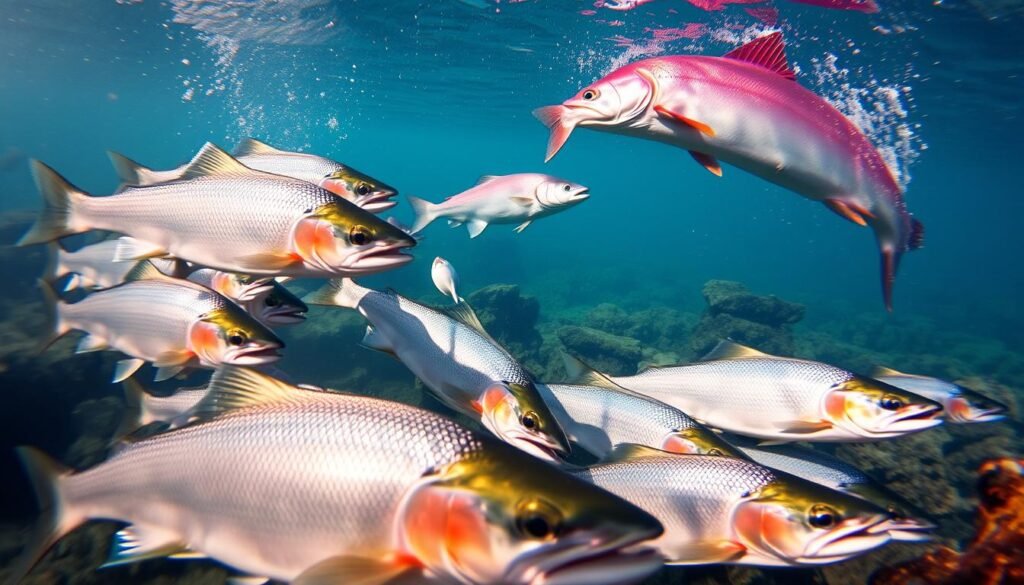
Best White Wines for Fish Pairing
The world of white wine offers a diverse range of options for pairing with fish, each with its unique characteristics and pairing potential. When making a fish dish with white wine sauce, selecting the right wine is essential to achieve the perfect balance of flavor.
Chardonnay: The Versatile Option
Chardonnay is a versatile white wine that pairs well with a variety of fish dishes. Its full-bodied flavor and good balance between acidity and sweetness make it an excellent choice. Unoaked Chardonnay complements delicate white fish, while oaked varieties stand up to richer seafood dishes. The buttery notes in some Chardonnays also make them perfect partners for fish served with cream-based sauces or butter preparations.
Sauvignon Blanc: The Crisp Choice
Sauvignon Blanc is known for its bright acidity and herbaceous flavor profile, making it a great match for fish with strong flavors. It works exceptionally well with herb-crusted fish, citrus-based preparations, and dishes featuring green vegetables. Its crisp taste cuts through the oils in fish, adding a refreshing citrus element to the pairing.
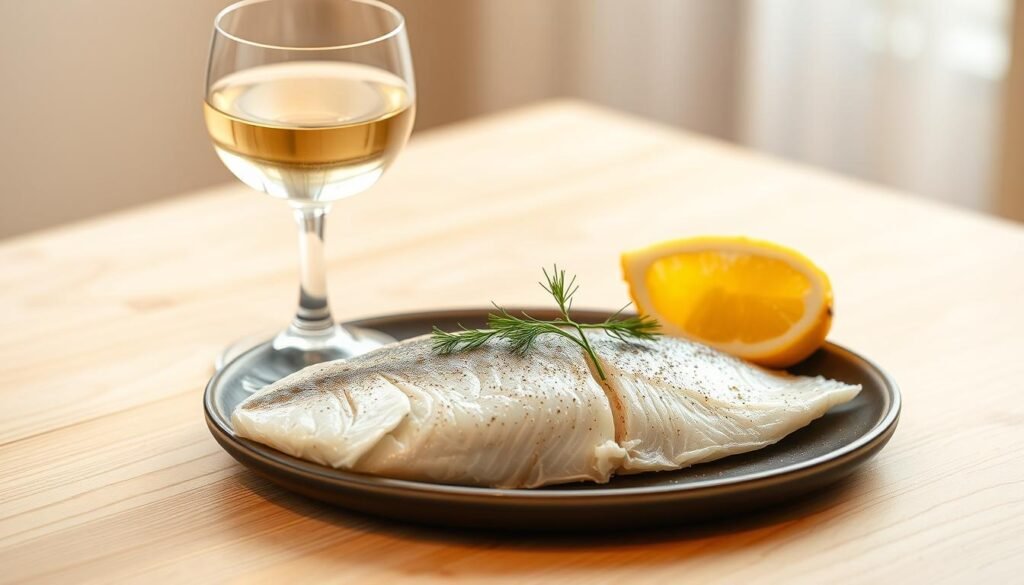
Pinot Grigio: The Light and Refreshing Selection
Pinot Grigio provides a light, refreshing option with subtle fruit flavors that won’t overpower delicate fish varieties. Its clean profile makes it an excellent choice for simply prepared fish dishes where you want the natural flavors to shine.
Other White Wine Varieties to Consider
Other white wine varieties worth considering include Albariño, perfect for pairing with shellfish, Riesling, great with spicy fish dishes, and Vermentino, excellent with Mediterranean fish preparations. For more information on pairing wine with fish, you can visit BBR’s guide on British summer fish and.
| White Wine | Fish Type | Preparation Method |
|---|---|---|
| Chardonnay | Delicate white fish | Grilled or baked |
| Sauvignon Blanc | Herb-crusted fish | Pan-seared |
| Pinot Grigio | Simply prepared fish | Steamed or poached |
Pairing White Wine with Mild Fish
Mild fish varieties offer a delicate canvas for white wine pairings that can enhance their subtle flavors. The key to a successful pairing lies in understanding the characteristics of the fish and selecting a wine that complements its delicate taste.
Bass and Branzino Pairings
Bass and branzino are versatile fish known for their mild, sweet flavor and tender flesh. A crisp white wine like Vinho Verde from Portugal pairs beautifully with these fish, adding a refreshing touch to their delicate taste. For a more conventional choice, a French or California Sauvignon Blanc can also complement their subtle flavors without overpowering them.
Sole and Flounder Combinations
Sole and flounder offer a slightly meatier texture while maintaining delicate flavors, making them suitable matches for textured white wines. Grüner Veltliner or Muscadet can pair nicely with these fish, as their mineral notes and good acidity enhance the subtle sweetness of sole and flounder.
Tilapia and Catfish Matches
Tilapia and catfish, despite their varied reputations, provide sweet and flaky flesh that can be paired with bright white wines. For tilapia, a New Zealand Sauvignon Blanc can be a great match, while breaded catfish can be complemented by an oaked Chardonnay. The preparation method of these fish can influence the wine pairing, making them versatile options for different culinary approaches.
- Bass and branzino feature delicate flavors that pair well with crisp wines like Vinho Verde.
- Sole and flounder are enhanced by wines with good acidity and mineral notes.
- Tilapia and catfish can be paired with bright Sauvignon Blanc or oaked Chardonnay.
For more information on pairing wine with specific types of fish, such as salmon, exploring various wine options can further enhance your dining experience.
Medium-Textured Fish and Their Wine Companions
Medium-textured fish present a versatile canvas for white wine pairings, balancing flavor and texture. These fish offer a middle ground between the delicacy of mild fish and the richness of meaty fish, making them incredibly adaptable to various white wines.
Trout and Arctic Char
Trout and Arctic Char are excellent examples of medium-textured fish, boasting nutty flavors and a moderate oil content. Trout has a delicate flavor with a nut-like quality and definite fish oils, while Arctic Char sits between trout and salmon in terms of flavor, being slightly oilier but still very flaky. A crisp New Zealand Sauvignon Blanc pairs beautifully with these fish, as its acidity cuts through their richness while complementing their distinctive flavors.
Snapper, Grouper, and Cod
Snapper, grouper, and cod are popular medium-textured fish known for their mild, sweet flavors and medium-firm texture. These characteristics make them versatile for wine pairing, particularly with Chenin Blanc varieties. The cooking method and accompanying sauces can influence the choice of white wine, allowing for a range of pairing options.
Chilean Sea Bass: A Special Case
Chilean Sea Bass stands out with its buttery, melt-in-your-mouth texture, deserving premium white wine pairings. Wines like Sancerre or White Burgundy complement its rich, buttery character without overwhelming its delicate flavor. Understanding the textural differences between these medium-bodied fish is key to selecting wines with the appropriate body and structure for balanced pairings.
Pairing Wine with Meaty Fish
Meaty fish, with their rich flavors and firm textures, require careful consideration when selecting a wine. These substantial fish varieties, including tuna, salmon, and swordfish, offer a unique challenge for wine pairing due to their dense, meaty characteristics.
Tuna and Wine: Beyond White
Tuna is a deep red fish with a thick, meaty texture and a distinctive flavor that’s both mild and less fishy than other seafood. For raw tuna or dishes with light Asian spices, a vibrant Sauvignon Blanc pairs well. For darker cooking styles, a textured white like Grüner Vetliner is a good choice.
Salmon Pairings for Every Preparation
Salmon’s rich, oily nature makes it a great match for full-bodied whites like Chardonnay or Viognier. Different preparations call for different wines: smoked salmon pairs nicely with sparkling wine, grilled salmon with Pinot Noir, and poached salmon with unoaked Chardonnay.
Swordfish, Mahi-Mahi, and Other Firm Fish
These firm fish have steak-like textures that can stand up to fuller-bodied white wines and even light reds when grilled or charred. The cooking method significantly impacts the ideal wine pairing, with grilling or blackening calling for more robust wine choices.
| Fish Type | Recommended Wine | Cooking Method |
|---|---|---|
| Tuna | Sauvignon Blanc, Grüner Vetliner | Raw, Grilled |
| Salmon | Chardonnay, Viognier, Pinot Noir | Smoked, Grilled, Poached |
| Swordfish, Mahi-Mahi | Full-bodied whites, Light reds | Grilled, Charred |
Shellfish and Wine: A Match Made in Heaven
The union of shellfish and wine is a timeless classic that evokes the essence of summer. Shellfish and white wine are a classic combination that has been celebrated in culinary traditions for centuries. This pairing is not only delicious but also versatile, offering a range of options to suit various tastes and preparations.
Delicate Shellfish: Scallops and Shrimp
Scallops and shrimp are known for their sweet and delicate flavors, making them a perfect match for crisp white wines. For lighter preparations, Sauvignon Blanc is an excellent choice, while richer dishes are complemented by Chardonnay or South African Chenin Blanc. These wines enhance the natural sweetness of the shellfish while providing enough acidity to cut through rich sauces.
Briny Choices: Oysters, Mussels, and Clams
Briny shellfish like oysters, mussels, and clams bring distinctive ocean flavors to the table. These are wonderfully paired with mineral-forward whites such as Spanish Albariño or crisp Muscadet. The natural saltiness of these shellfish creates a delightful contrast with the citrus and mineral notes found in these white wines.
Luxurious Options: Lobster and Crab
Luxurious shellfish like lobster and crab deserve equally premium wine pairings. Buttery Chardonnay is a classic choice that complements their rich, sweet meat. For a less traditional pairing, dry Chenin Blanc offers enough body to match these premium shellfish while providing a refreshing contrast to their richness.
Understanding the flavor intensity and preparation method of each shellfish variety is key to selecting the perfect white wine companion for your seafood dish. Whether you’re enjoying delicate scallops or luxurious lobster, there’s a white wine out there to enhance your dining experience.
Classic White Wine Sauce for Fish
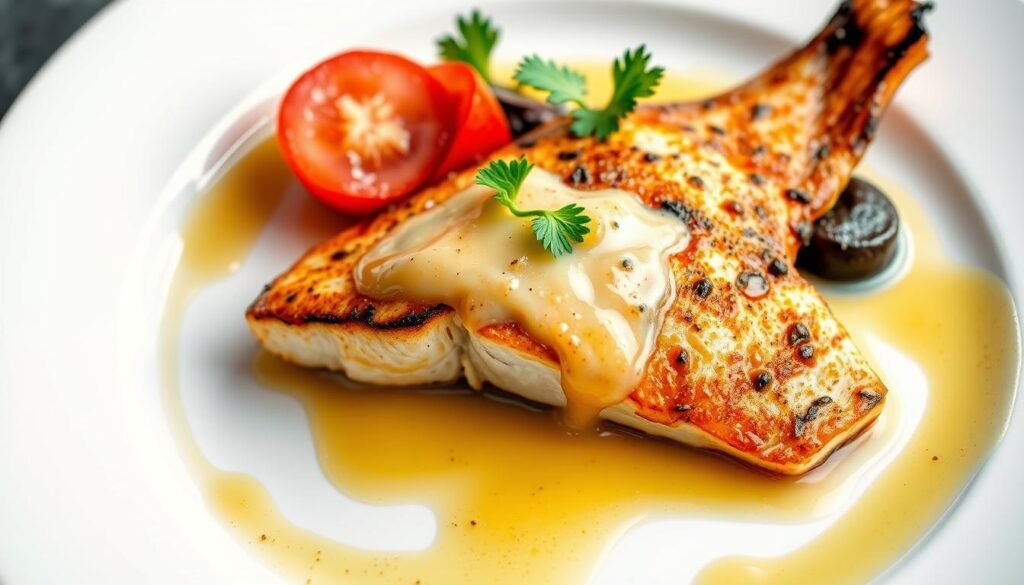
Elevate your seafood dining experience with a classic white wine sauce that’s both luxurious and easy to prepare. This white wine sauce for fish transforms simple fillets into an elegant restaurant-quality dish with just a handful of essential ingredients.
Essential Ingredients
The key components of this sauce include dry white wine (Chardonnay works beautifully), cold butter for emulsification, shallots, garlic, lemon juice, cream, and fresh herbs. Quality ingredients make all the difference in this recipe, though you don’t need an expensive wine as the subtle flavors are lost during cooking.
Step-by-Step Preparation
Begin by cooking your chosen fish in a skillet until golden, then remove it and keep it warm in a low oven. In the same pan, reduce white wine with shallots, lemon juice, salt, and pepper until the liquid is reduced by half. Add cream to the skillet and simmer briefly before incorporating cold butter cubes one at a time while stirring constantly over low heat.
Variations and Serving Suggestions
This versatile sauce works beautifully with nearly any pan-fried fish, from delicate sole to meatier options like snapper or cod. Serve the sauce-coated fish with simple sides like pea puree, asparagus, or cauliflower mash to let the elegant flavors of the white wine sauce shine. You can also add fresh herbs like dill or tarragon for a unique twist.
Pairing Challenges: Smoked and Strong-Flavored Fish
Smoked and oily fish present unique challenges when it comes to pairing with white wine. These types of fish are characterized by their intense flavors and aromas, which can be overwhelming for many wines.
Navigating Smoked Fish Pairings
Smoked fish, such as smoked salmon, can be particularly challenging to pair due to their strong flavors and high salt content. Cold-smoked fish fillets pair well with crisp, light wines like Sancerre or Chablis, which can cut through the oiliness while complementing the fish. On the other hand, hot-smoked fish varieties develop deeper, more intense flavors that require wines with more body and spice, such as dry Gewürztraminer from Alsace.
Solutions for Oily and Pungent Fish
Oily and pungent fish like mackerel, sardines, and anchovies contain high levels of natural oils and distinctive flavors that can overwhelm many white wines. To combat this, wines with pronounced acidity, such as Muscadet or Pinot Grigio, can help cut through the oils and cleanse the palate. Alternatively, sparkling wines offer another excellent solution, as their effervescence and acidity provide a refreshing contrast to the rich, oily flesh. Creative preparation methods, such as incorporating lemon juice or vinegar in sauces, can also help tame these strong flavors and make wine pairing more successful.
Conclusion: Elevating Your Fish Dining Experience
Elevating your fish dining experience is easier than you think with the right white wine pairing. By understanding the basics of pairing white wine with fish, you can transform everyday meals into memorable dining experiences. Experiment with different white wines like crisp Sauvignon Blanc or buttery Chardonnay to find your perfect match. Don’t be afraid to try new combinations and presentation styles, such as serving your fish on a dark-colored plate with a vibrant side dish like green pea puree. For more tips on elevating your dining experience, visit our guide on perfect wine pairings.

